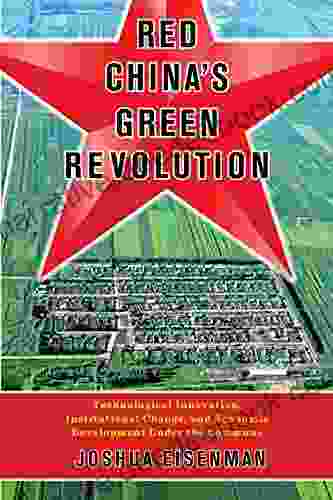China's Green Revolution: Transforming Agriculture, Feeding the Nation, and Reducing Poverty

The Green Revolution is widely regarded as one of the most significant agricultural transformations in human history. It refers to the period of agricultural development that began in the mid-20th century, characterized by the adoption of new technologies and practices that dramatically increased agricultural productivity. China's Green Revolution, which took place from the late 1970s to the early 2000s, was particularly remarkable for its speed, scale, and impact. In this comprehensive article, we will delve deep into China's Green Revolution, exploring its history, key features, successes, challenges, and long-term implications for the nation and the world.
A Historical Perspective: From Hunger to Abundance
Prior to the Green Revolution, China faced severe food shortages and chronic malnutrition. The population was rapidly growing, while agricultural yields remained stagnant. In 1978, only a year after the end of the Cultural Revolution, China's grain output stood at a mere 300 million tons, leaving a significant gap between supply and demand. The situation was further exacerbated by a series of natural disasters, including droughts, floods, and typhoons.
5 out of 5
| Language | : | English |
| File size | : | 3684 KB |
| Text-to-Speech | : | Enabled |
| Screen Reader | : | Supported |
| Enhanced typesetting | : | Enabled |
| Word Wise | : | Enabled |
| Print length | : | 474 pages |
Determined to address the looming food crisis, China embarked on a comprehensive agricultural modernization program. This program, guided by the visionary leadership of Deng Xiaoping, sought to transform the country from an importer of grain to a self-sufficient producer. With the of new technologies and policies, China embarked on a path that would not only reshape its agricultural sector but also have profound implications for the nation as a whole.
Key Features of China's Green Revolution
China's Green Revolution was characterized by a number of key features that set it apart from similar transformations in other countries. These features include:
1. Emphasis on Science and Technology: China invested heavily in agricultural research and development, establishing numerous institutes and universities dedicated to the advancement of agricultural sciences. Chinese scientists developed improved crop varieties, including high-yielding hybrid rice and wheat, which significantly increased yields.
2. Comprehensive Extension Services: The government established a vast network of extension services to provide farmers with access to knowledge, training, and support. This network played a crucial role in disseminating new technologies and practices to rural communities.
3. Marketization of Agriculture: China gradually dismantled the centralized planning system that had dominated agricultural production since the 1950s. Farmers were given autonomy in decision-making and allowed to sell their surplus produce on the market, creating incentives for increased production.
4. Rural Infrastructure Development: The government prioritized investments in rural infrastructure, including irrigation systems, roads, and electricity. This improved access to inputs, markets, and essential services, further boosting agricultural productivity.
Successes of China's Green Revolution
China's Green Revolution achieved remarkable successes in a relatively short period of time. The country's grain output soared from 300 million tons in 1978 to over 600 million tons in 2008, making China the world's largest grain producer. This increase in production not only averted the looming food crisis but also led to a significant decline in food prices, improving the living standards of millions of Chinese people.
In addition to increased grain production, the Green Revolution also led to improvements in other areas, such as:
1. Diversification of Agricultural Production: While grain remained the primary focus, the Green Revolution also promoted the production of cash crops, such as vegetables, fruits, and livestock. This diversification provided farmers with additional sources of income and reduced the risk associated with relying on a single crop.
2. Increased Employment Opportunities: The expansion of the agricultural sector created numerous employment opportunities in rural areas. This helped to reduce poverty and improve the economic well-being of rural communities.
3. Environmental Sustainability: The adoption of high-yielding crop varieties and improved irrigation systems led to more efficient use of water and land resources. This helped to mitigate the environmental impact of agricultural production.
Challenges and Limitations
Despite its undeniable successes, China's Green Revolution also faced a number of challenges and limitations, including:
1. Environmental Concerns: The intensive use of chemical fertilizers and pesticides raised concerns about environmental degradation and soil health. The government later introduced policies to promote sustainable agricultural practices and reduce the environmental footprint of agriculture.
2. Inequality and Rural-Urban Disparities: While the Green Revolution benefited many farmers, it also contributed to growing inequality between rural and urban areas. The influx of cheap food to urban centers led to a decline in agricultural prices, squeezing the profit margins of small-holder farmers.
3. Overproduction and Market Fluctuations: China's rapid increase in agricultural production led to oversupply and market fluctuations, resulting in periodic declines in prices and farm incomes. The government implemented various policies to stabilize markets and support farmers.
Long-Term Implications
China's Green Revolution has had profound long-term implications for the nation and the world. The increased agricultural productivity freed up labor from the countryside, contributing to China's rapid industrialization and economic growth. The country's transition from a food importer to a food exporter has also strengthened its global standing and influence.
Furthermore, the Green Revolution's focus on science and technology has established China as a leader in agricultural research and development. Chinese scientists have made significant contributions to global
5 out of 5
| Language | : | English |
| File size | : | 3684 KB |
| Text-to-Speech | : | Enabled |
| Screen Reader | : | Supported |
| Enhanced typesetting | : | Enabled |
| Word Wise | : | Enabled |
| Print length | : | 474 pages |
Do you want to contribute by writing guest posts on this blog?
Please contact us and send us a resume of previous articles that you have written.
 Novel
Novel Page
Page Chapter
Chapter Story
Story Library
Library Sentence
Sentence Shelf
Shelf Glossary
Glossary Bibliography
Bibliography Synopsis
Synopsis Manuscript
Manuscript Codex
Codex Tome
Tome Bestseller
Bestseller Classics
Classics Library card
Library card Autobiography
Autobiography Memoir
Memoir Reference
Reference Dictionary
Dictionary Thesaurus
Thesaurus Narrator
Narrator Librarian
Librarian Catalog
Catalog Card Catalog
Card Catalog Borrowing
Borrowing Stacks
Stacks Archives
Archives Study
Study Research
Research Lending
Lending Academic
Academic Rare Books
Rare Books Interlibrary
Interlibrary Literacy
Literacy Thesis
Thesis Awards
Awards Reading List
Reading List Book Club
Book Club Theory
Theory James C Robinson
James C Robinson Matthew Cummiskey
Matthew Cummiskey Michael W Shurgot
Michael W Shurgot Gary Mottram
Gary Mottram Michael Heney
Michael Heney Tal Ben Shahar
Tal Ben Shahar Edward C Benzel
Edward C Benzel Greater Than A Tourist
Greater Than A Tourist Kaitlin Solimine
Kaitlin Solimine Alex Watson
Alex Watson Miguel A Sanchez Rey
Miguel A Sanchez Rey Steven A Cook
Steven A Cook Mark Brend
Mark Brend Emma Jones
Emma Jones Robert Horvath
Robert Horvath Anthea Peries
Anthea Peries J B O Neil
J B O Neil Emma Moreau
Emma Moreau Peter E Quint
Peter E Quint Susan M Tiberghien
Susan M Tiberghien
Light bulbAdvertise smarter! Our strategic ad space ensures maximum exposure. Reserve your spot today!
 Russell MitchellFollow ·9.9k
Russell MitchellFollow ·9.9k Benji PowellFollow ·6.5k
Benji PowellFollow ·6.5k Michael SimmonsFollow ·5.7k
Michael SimmonsFollow ·5.7k Bryson HayesFollow ·11.2k
Bryson HayesFollow ·11.2k Holden BellFollow ·9.4k
Holden BellFollow ·9.4k Jared NelsonFollow ·5.9k
Jared NelsonFollow ·5.9k Charlie ScottFollow ·18k
Charlie ScottFollow ·18k Kenzaburō ŌeFollow ·3.9k
Kenzaburō ŌeFollow ·3.9k

 Dallas Turner
Dallas TurnerParasols and Peril: Adventures in Grace
In the quaint town...

 Caleb Carter
Caleb CarterFlight Attendant Joe: A Dedicated Professional in the...
Flight Attendant Joe...

 Jerry Ward
Jerry WardPick Lottery The List For 23 States August 15 2024
The Pick Lottery is a multi-state lottery...

 Hudson Hayes
Hudson HayesHow the Media Wields Dangerous Words to Divide a Nation
In a world where the media is...

 Curtis Stewart
Curtis StewartThe Magic Mala: A Story That Changes Lives
In the realm of ancient traditions and...

 Raymond Parker
Raymond ParkerEarthly Meditations: A Poetic Tapestry of Nature,...
In the realm of contemporary...
5 out of 5
| Language | : | English |
| File size | : | 3684 KB |
| Text-to-Speech | : | Enabled |
| Screen Reader | : | Supported |
| Enhanced typesetting | : | Enabled |
| Word Wise | : | Enabled |
| Print length | : | 474 pages |












